What is Living Story Web?
David M. Boje 22 May 2012; revised Jun 21 2018
ABSTRACT
I define the entirety of 'storytellng' as the whole three interweaving sociomaterial energies: (1) 'living story webs' in space-time-materiality event-ness, with (2) more abstract 'grand narratives' and counternarratives,and (3) interconnected by quantum processes of 'antenarrative.' Simply put, antenarrative comes before both living story webs and grand narratives-counternarrativesin five interconnected ways: (1) Before narrative & story are antenarrative processes of preparing in advance; (2) Beneath narrative & story are antenarrative processes of language, concepts, symbols in order to develop them; (3) Between are structures that need to be bridged to have narrative & story emerge; (4) Bets on the Future are the prospective sensemaking attempts to bring potential futures into being-ness; and (5) Becoming of care, the intuitive becoming of realizing particular futures, caring for one of them is what we call collapsing the wave. Antenrrative has four patterns: linear-antenarrative, cyclical-antenarrative, spiral-antenarrative, and rhizomatic-antenarrative. Two pathways between living story and grand narrative, the linear- and cyclic-antenarratives are from past predicted to recur in the future. The linear patternis known as retrospective sensemaking, looking backward at history, at what is arriving into the now.The antenarrative is a prospective sensemaking process that is looking forward at what is arriving from the future into the now. The other two pathways are from the future to the past, in a radical telos causality that requires a discussion of Heisenberg/Bohr, in relation to Heidegger, Barad, Bakhtin, Deleuze, Mead, and Arendt's material ontologies, and what I am calling 'quantum storytelling.' Quantum storytelling is an ontology, and a new language of quantum ways of talking about that ontology. Quantum storytelling is pragmatic (Boje, 2014). It is a move away from the language and ways of Newtonian mechanistic-materialist and Linguistic turn (aka social constructivist) ontology. It begs the question, of what is our new living story identity, the Embodied Self in the Quantum Age? My answer is it the epistemic-narrative 'self' surrendering the ontological 'Embodied Self' of living story.
Introductory Starting Definitions
Here is a diagram of the three aspects of the entirety of storytelling.
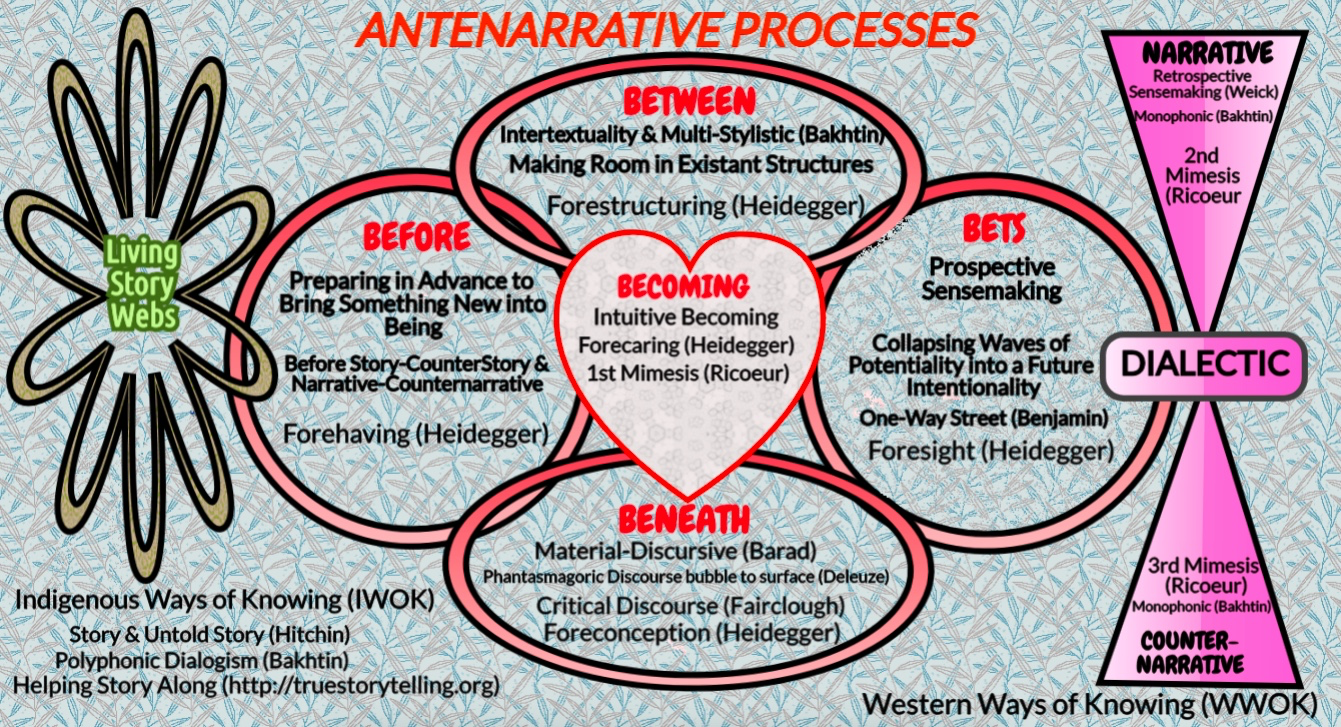
Figure 1: The Three Components of the Entirety of Storytelling (Living Story Webs, Antenarrative Processes, & Narrative-Counternarrative Dialectic)[Boje, 2018a, b]
Living story (&counterstory) webs and grander narratives-counternarratives interplay through the 5 B's of antenarrative (Before, Beneath, Between, Bets, & Becoming). I began writing about just the Before and the Bets in the 2001 book on Narrative Methods. In the last 7 years, I have beeen working out the Beneath, Between, and Becoming aspects of antenarrative theory. Living story, for me, has always been an indigenous concept, beginning with Kaylynn TwoTrees (1997, 2000) who defines 'living story' as having a place, a time, and a mind of its own. That means that living story is ontological, existing in spacetimemattering (as Barad, 2007 calls it). It means that a living story is embodied in not just the person, but in the (tribal) community, and in the living ecology (Cajete, 2000). We live the 'living story' in our daily lives, and the 'living story' takes on a life all tis own, and lives through us. Living stories are an Indigenous Way of Knowing (IWOK) and are not at all the same as their nemesis, the grand narratives and counternarratives which are Western Ways of Knowing (WWOK). WWOK typically erases and otherwise marginalizes IWOK living stories, but editing out most the the events of history, most of the characters it finds marginal, and focuses in on just a few events and a few bigger than life characters and one or two helpers. In other words, IWOK is a deeper and more complete history in the entire web of living stories. Some western writers, have arrived at this understanding of the differences between 'narratives' and 'stories' (without appeal to IWOK. For example, Mikhail Bakhtin, defines narratives as 'always' monological (having one logic of one plot, a few events and a centeral character), where as stories can be polyphonic (one of several dialogisms, see Boje, 2008 for more on this topic).
"For Bakhtin (1973: 12) ‘narrative genres are always enclosed in a solid and unshakable monological framework.’ Coherence narrative posits
mono-system-wholeness, mergedness, and finalizedness. The single observer posits unitary mono event horizon wholeness with one complexity property" (as cited in Boje, 2008: 43)."Polyphonic is fully embodied voices, not in hierarchy. They fully engage and debate one another, including author’s voice" (as cited in Boje, 2008: 39).
Jacques Derrida looks at narrative as interrogation, a demand to disloce, and as phallologocentrism (because the main character is usually caught in a male world and a logocentrism-one logic).
"… The question-of-narrative covers with a certain modesty a demand for narrative,
a violent putting-to-the-question an instrument of torture working to
wring the narrative out of one as if it were a terrible secret in ways that can
go from the most archaic police methods to refinements for making (and even
letting) one talk that are unsupposed in neutrality and politeness, that are
most respectfully medical, psychiatric, and even psychoanalytic" (1991: 261)."Each ‘story’ (and each occurrence of the word ‘story,’ (of itself)) each story
is at once larger and smaller than itself, includes itself without including (or
comprehending) itself, identifies itself with itself even as it remains utterly different from its homonym" (Derrida, 1991: 267).
This idea by Derrida that each sotry is at once plart of something larger and something smaller, dovetails with IWOK, since each story is an invitation to tell another living story, and in a community or organizaiton, these invites constitute a web of living stories, that are unfolding, in-the-middle, without beginning or end. There are some 40 definitions of narrative and of story (see Boje, 2014 for a table of them and thier authors). For now, we ill proceed with the notion that WWOK narrative-counternarrative and IWOK living stories (& counterstories) are different, yet are interplaying with one another.
Antenarrative patterns began to get worked out in the 2011 Antenarrative Handbook. The spiral- and rhizomatic-antenarratives are future-->present and future-->past destining, directionalities futurals, drafts (up or down, in & out, left or right quantum directions), and disclosabilites of quantum materiality in a vitalistic sense of living story. Living story is ontological in its Being-in-the-world, its aliveness primordially in lived-life from birth to death. Storytelling is the inter-weave of living story webs, grand narrative retrospection, and connective antenarratives that are before, between, beneath, becoming, and the bet of potential-for-Being-a-whole (Heidegger, 1962). These various antenarratives (linear-, cyclical-, spiral-, & rhizomatic-) are fractal, scalabilities of repetition and difference (Boje, 2016; Henderson & Boje, 2016; Boje & Henderson, 2014).
Antenarratives afford different conceptions and enactments of Baradian spacetimemattering. And it is through storytelling that grand narrative works out its universalizing gesture, its relationship with living story web's Being-ness through linear- and cyclical-antenarrative. Grand narratives and counternarratives are always monologic, emptying out the diverse aliveness content of living story and counterstory webs. And it is through storytelling that living story webs work out thier own particularistic ontological Being of an avenir (French for future that is shaped and shaping), a future arriving through the spiral- and the rhizomatic-antenarrative to restory the grand narratives of the past, and resituate the living story web of relationships unfolding in the Present that is without beginning or end. And so here we have two identities, the 'self' of ordinary space-time where 'self' is antenarratively linear or cyclic recurrence from narrative past to future. And the more radical 'Self' that is ontologically a future arriving-ahead-of-itself, to restory the past-narratives via the spiral- and rhizomatic-antenarrative pathways, and even reenliven the Present. So, what is storytelling when these the 'self' and the 'Self' come into negotiation?
There are many ontologies, and I have been relating antenarrative to several of them, begining with Derrida and Bakhtin in Boje (2001), and by 2014 I was working out the 5 B's using two of Heidegger's (1999 Ontology--The Hermeneutics of Facticity and 1962 Being & Time) texts. I work out the German translation of key terms by working with native-German speaker Sabine Trafimow, who attends all my doctoral seminars in Las Cruces, and for past 4 years has been faithfully dong etymology and historical work on the key concepts. Heidegger is notorious for concocting his own meanings of common and uncommon German words. Her work continues to be invaluable.
Forecaring Initally Forecaring was just the notion of 'Becoming' without a Heideggerian tie. However, around 2012 I began to study the ontology of becoming, between, and beneath in Hiedegger (1962 & 1999). Heidegger (1999: 75), for example develops “fore-care” as “care-being-encountered-in-advance in an inexplicit manner is motivated in availability in advance and how care contributes precisely to the authentic character of the there of what we encounter.” Fore-care combines ‘fore’ meaning of in advance, with care in the environing world in “forehaving of caring”, “Being-encountered-in-advance” ‘availability in advance’ (Heidegger, 1999: 130 footnote #62). Fore-care has the related term “being-encountered in advance” (Vorbegegnen) (Heidegger, 1999: 122, footnote 68). Fore-care (sorge) combined with fore (Vor), Vor-sorge, foreconception is Vorgriff, forehaving is Vorhabe and Vorweghaben (anticipatory forehaving), foresight is Vorsicht (Heidegger, 1999: 132 Glossary). You do find the concept of care throughout Heidegger (1962) but no mention of forecare or forcaring.
Forehaving Forhaving is worked out in both Heidegger texts, and has a very different sense of temporality than the usual retrospective narrative of WWOK. Forehaving (Vor-sorge) is before (in advance) preparation (something we have in advance, Vor-habe) that is beforehand to narrative. Fore-conception (Vor-griff) is something we grasp in advance. Fore-structure (Vor-struktur) is structuring in advance, ahead of, in anticipation. Foresight (Vor-sicht) is something we see in advance (Vorsicht).
First Principle of Systemicity: As long as the Living Story Web is an entity, it has never revealed its wholeness. In 'systemicity' (Boje, 2008a, 2014) the Being-a-wholeness is questioned, ontologically (for more on Systemicities, click here). The Living Story Web is anihiated when that is still outstanding in the constitution of the web's Being has been liquidated (Heidegger, 1962: #236). What is still outstanding in constituteng the Living Story Web becomes "on-longer-Being-there" (#236). As long as the Living Story Web is still an entity, it lacks totality, some web-strands of relationship-building, are still outstanding. The storytelling-spider still has more weaving to do. For the storytelling-spider the is "constantly something to be settled" [eine standige Unabgechlossenheit] (#236).
What is this web? It is a weaving together of grand narrative tie-strands with the Living Story strands that spiral through them, and each strand of connection is an antenarrative. The Living Story Beb, as an entity, has the possiblity-for-Being-a-whole, and ove Being presented [Vorgabe]. This is its hermeneutical Situation as web-entity, as web-existing, that can become "accessible in its Being-a-whole" (#236).
This storytelling-spider comports itself in web-weaving towards the web's "potentiality-for-Being" and to be settled [abgeschlossen] and by its care to still be "ahead-of-itself" temporally and spatially (#236).
Some web strands tear away form the possiblities. The weavers work on the entire web, and as strands tear aware the storytelling-spiders are not plunged into hopelessness. Some strand are fashioned from grand narrative Illusions, and heare the web "'ahead-of-itself' lies hidden" in the "structure of care" (#236).
The Living Story Web-entity evolves in relation to grand narratives of generality. Web-entities are encountered as yet not-whole, "within-the-world" and "within-time-ness" (#235). Only in retrospect would any spider-weaver say the web is a whole, or would never say the whole-web is greater than the sum of its strands. This meaning of Living Story Web is grounded in the understanding and interpretaiton of Being, where the "horizong of time" is a projection of many stranded meanings, including the web's own "potentiality-for-Being-a-whole" a web in its everydayness "within-time-ness" is never yet whole (#236). When the web becomes "accessible in its Being-a-whole" the storytelling-weaver-spiders must be dead and gone.
"Time-reckoning" is developed in the Storytelling, differently in retro-grand narrative strands of generalizing and abstraction of wholes everywhere, than in Living Story Web strands of primordial meaning of what lies ahead to be woven-anew, repaired, woven-around, and rewoven (#235). The very Being of the web is an issue of care for the web, by reckoning the temporality of the web-entity. The weaving of Storytelling, of weaving grand narratives in relation to Living Story Web is in a spatial ontology (part V and VI of Heidegger, 1962) and in the "horizong of time" a pprojection os so many primortial meanings and "potentiality-for-Being-a-whole" (#235).
My point here, of course, is the web is never a whole system, except in the retrospect of grand narrative Illusion. In its everydayness "within-time-ness" the spatiality and temporalizing of time itself is weaver's storytelling in the "ontological meaning of care" towards the web's "potentiality-for-Being, a whole which is always still "agead-of-itself" (#236).
LIVING STORY WEBS EXAMPLE
Each person, even Westerners, has their own unique living story strands being woven into a web-ness. Living story web has a place, a time, and a quantum-materiality (see definitions that follow).
My place, my ontological-spatiality: David M. Bøje is half-Danish and half-Scottish, and resonates with those now far-away places. My time is primordial from womb to tomb, across 7 plus 7 generations of Bøjes, a crossing of Viking on my Danish side with Druid on my Scottish side, courses through my veins. My living story web of Self, is inter-generational, extending at least back seven generations, and a future arriving ahead-of-itself from at least seven more generations. There are many kinds of materiality. My Self is an energy Being, in a world of energies, within a Milky Way of energies, in a universe of energies. My web will never be whole. Not only is my Living Story entangled in places and times of generations past and future, there are currents and vortices of energy that entangle me intergenerationally, and cross-culturally. For example, it is not just Danish and Scottish that I integrate.
After immigrating form Europe, both sides of the family married into Native American tribes. And the rest of the family wrote them out of the history books. The microstoria (Bøje, 2001), the ways those Native American Bøjes resisted the grand narratives (manifest destiny, Euro-American colonialism, western capitalism, etc.) has a 7+7 intergenerational soul-wounding on the Bøje settlers (Duran, 2006). It is the internalized oppression, Duran calls being bitten by the vampire of a "measured historical trauma" and carries forward "symptoms of emotional distress" connected to the genocied of Amderican Indian people (p. 17). For me, its less about emotion, and more about what Heidegger (1962) calls attunement or moods, where my body is attuned to the social body, the Nature body, the cosmic body (See more on moods of attunement to systemicities).
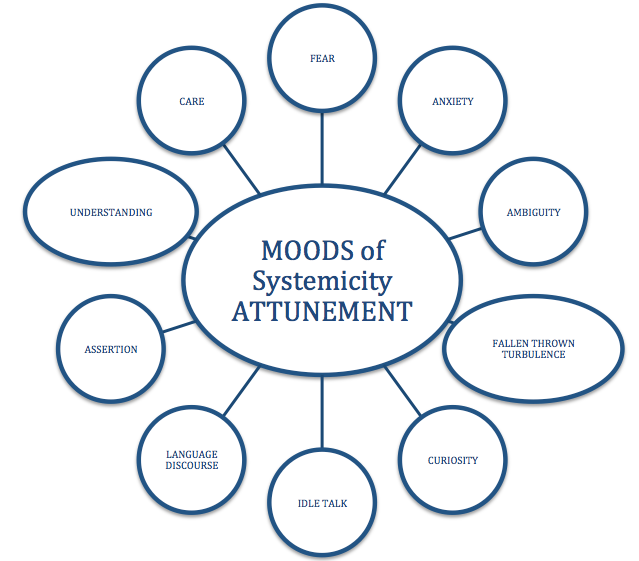
Figure 1 - Moods of Systemicity Attunement (Drawing by Boje, Sep 23 2014) [source: moods of attunement to systemicities]
So many living stories, a web of so many moods entangled, in and across 7+7 generations.
My Scottish Side
My mother, Lorane Joyce Eaton, told me the name of my grandmother, here actual name, but not till I was 53 years old. It is Wilda Shelton Eaton (born Jan 28 1902)
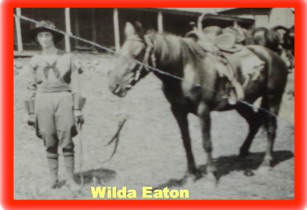
You can see a tear in the photo. My mother ripped it up, and tossed it away. "Why did you do that" I asked. "Why do you care. I hate all this" (Boje, 2005, see more on Wilda).
This act of carelessness, prompted a mood of care in my deepest Self. Why did my mother wait so long? Why was she so bitter, so angry, and for so very long? Wilda, or 'Wild-A' as I call her now, was a a wilderness woman. She was a trick rider in the rodeo, as my mother tells it, "when women did not do that sort of thing."
Wilda lived in tents when husband Ray Eaton, worked for Railroad or picked apples after she took up with Brownie (2nd husband). When Wilda was a teenager, she went up with grandpa at the forest service. She would prop her leg up on the saddle and roll up a cigarette with one hand. Valla (Val for short, my mom's step-sister) could do that too. When they worked in the forest, they did not have a telephone, but could shinny up the pole and make a phone call using a clip on phone thing. Wilda was a switchboard operator at one time. He dad had a livery stable in Goldendale when he quit wheat ranching.
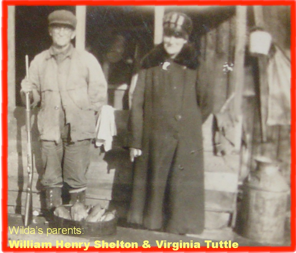
Wilda's parents William Henry Shelton and Virginia Tuttle (maiden name) were formers, of Scottish ancestry, who took a covered wagon, and crossed the Rocky Mountains, on the Old Oregon Trail. Wilda's baby brother died in the crossing. More soul wound. They were dirt poor, actually doing the crossing, some 50 years after it was fashionable, unable to afford the new-fangled transport, a passenger train.
Sheltons and Tuttle were likely to have been Presbyterians; Eatons were Baptist.
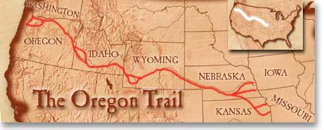
William Henry Shelton and his wife Virginia came to WN in covered wagon on the Oregon Trail in 1897; they were wheat farmers; one child (Henry Wayne) died on the trial.
Wilda’s sisters:
Pearl Shelton (born Jul 31 1869 in Chariton in Lucas county Iowa; died Nov 22 1954); married Herman Miller (Oct 21, 1908): child: Lucille who married Charles Greathouse (no children)Lillie Shelton (born Jul 5 1893 in Chariton Iowa) married Monroe Drury and then married James Crawford; children Denton, Edwin, Eleanor, Warren, Mildred, Gloria, & Henry
Wilda’s Brothers:
Henry Wayne Shelton (born Jan 16 1897 and died Feb 1897) died during the covered wagon journey from Iowa to WN over Chisholm TrailKassin Shelton (born Dec 12 1889; died May 17 1962) married Ora Saxton; children Virginia, James, Marjorie , Joseph
The wheat farming in Goldendale, Washington failed, and William and Virginia, among their daughters, Wilda (my grandmother), and brother Gerald, opened a livery stable and a blacksmith shop.
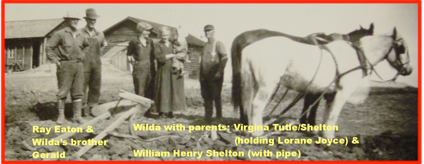
I asked my mother, "why did you ener tell me any of this." She replied, "its embarassing. Living like that, on dirt floors. Living off the land." My mother had no curiosity about her past or future, did not 'care' about it, and for her, this was all jsut 'idle talk' not useful for anything.
"Your grandmother (Wilda) married a bootlegger name Ray Eaton. He hop-ed freights and sold moonshine, when he was not hearding sheept." My great grandmother is holding my mother in above photo. These were photos I never saw until late in my life. My mother was acculturated, a suburbanite. She did not admit to wild living. She wanted to be modern. And yet, so many soul wounds issued forth, one could not help but notice.
To effect intergenerational soul healing, by rekindling my own family's understanding of how humans are one of many species, how stones, rivers, mountains, trees, and moss are all living Beings, is part of the intergenerational healing. My personal philosophy is posthumanist. Humans for many generations have presumed to be the only species of animal, or any life energy, that matters.
Posthumanists seek the sustainability of all species of animals, plants, as well as the sustainability of the elements of life itself. For me, those elements are earth, water, air, and fire.I took up blacksmithing to reconnect to the denied heritage, the family secret kept silent by my mother, of my great-grandfather, being a blacksmith, my grandmother and her brother, marrying Natives.
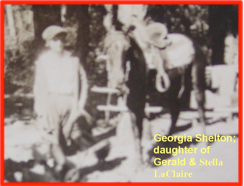
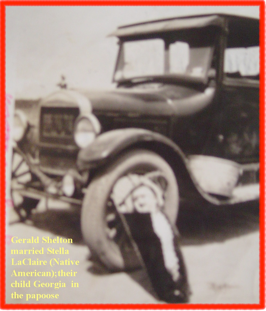
Gerald Shelton (born Jun 13 1904; died Aug 18 1937) married (or may have) Stella LaClaire (Native American, probably Yakima); children Georgia (or Georgie) & perhaps a Darlene; Gerald worked in circus and Rodeos; he as an alcoholic; was beaten by the police, and died in the Toppenish jail, WN; story told: threw him in so many times they got tired and just beat him to death).
Gerald Shelton was also a trick rider in the rodeo. He is standing in front of a Livery Stable and Blacksmith Shop.
That ancestor (Gerald Shelton), who married Stella LaClaire (probably Yakama tribe), and had a baby, named Georgia (whereabouts unknown), he was beatten to death by the local Sherif and his deputy, allegedly for being the town drunk, but more likely for more indigenous cross-cultural reasons. Thing is, in the photos my mother took out of an old shoebox, and let me photo them, then tossed them - he looks sober to me!
Raymond Eaton – Wilda met him when she was 16 or 17 years old in Cle Elum; did not see him from time mom was a year and a half. He bought her 5 pound box of chocolates, and said “I’m your daughter). As soon as I graduated I moved away from Brownie in 1944, and moved to Spokane and got a job at Alcoa/Trentwood Aluminum plant; because I could use an IBM typewriter got a job as secretary with one of the bosses, an industrial engineer; no one else could manage the light touch of the IBM typewriter; I took a bus out there; “Worked there until the plant closed after the War, 1946. It was quite a thing for a kid right out of High School and I could do 140 words per minute shorthand.” I flunked typing, could not pass a speed test; I was so ashamed of that because I had straight As (in everything else). “We can’t all be perfect. I was close to perfect all my life, perfecto; at least when I was a baby.”
Raymond Victor Eaton, for most of his life herded sheep; he went in to mining to hunt for gold and during the war for plutonium; hit a few good strikes with a partner. During the great depression he was a bootlegger (stock market crash was Black Tuesday, Oct 29 1929; New Deal 1933-1938). With one eye (lost in dynamite accident) he could not go into military.
Raymond joined the bootleggers; he began distilling alcohol in his home. Prohibition became a law earlier in Washington State (on Jan 1 1916), than in the nation. In fact Initiative No. 3, passed on Nov 1, 1914, Election Day, the citizens of Washington State, by a margin of 52 percent; it just did not take effect until Jan 1916. The Prohibition Amendment (The 18th Amendment to the U.S. Constitution, effective Jan 20 1920); Prohibition was repealed in Apr 15, 1933.
It is no accident my living story has taken me to working with veterans. Both sides of the tree, had lots of soldiers.
Raymond Victor Eaton’s father, Andrew William Eaton (born Dec 1845 in Indiana, near Mount Pleasant, died Jun 7 1934 Orting WN; famous oldest living survivor in WN of Civil War, most likely a Confederate). Resided in WN since 1889, was at old soldiers home Orting (WA Soldiers home no 2689). In Civil war Company H, Reg. 118th Illinois Infantry enlisted May 10 1864 with rank of private at Quincy IL serving in Captain Henry A. Castle’s Company A 137 Regiment of Illinois Infantry, discharged Sep 24 1864 at Springfield Il due to expiration of term of service, and then enlisted second time Feb 18 1865 as private at Baton Rouge, Lain Captain Colendar Rohrbough’s Company H 118th Regiment of Ills Mounted Infantry Volunteers and was discharged Oct 1 1865 at Baton Rouge, La, since serviced no longer required – at time he applied for pension 18 Aug 1914 he received $15.50 a month; age 69 went into home, he came there with pension of $100 a month in Garfield barracks (dated 8/22/33); length of military service 11 months. Also receive 22.50 per month as pension on certificate no. 1022381 in Alnicn Hall barracks; Buried section 4, Row H, Number 16. Andrew’s parents: William P. Eaton (born in TN; may have fought in Spanish American war); mother Margaret Force (born in, IN).
Wilda, my grandmother remarried. Percy Clarence Brown (born Mar 17 1894 in Ellensburg, WN; died Mar 20 1970); mother’s name is Stutsman (had a gadabout car); father was a rancher on farm, poor and uneducated. Percy’s mother gave him to an Indian reservation; Brownie went to Indian school until 3rd grade and hopped out window to go fishing and never went back. Percy’s brother was named Claude, and was raised by his mother in a life of wealth and privilege. It is own of those soul wounds, one brother raised in Native Indian school, on Yakima reservation, and the other one, raised in wealthy family.
He was raised by the Indians; Mama (Val) said he always said, Ikkes Cuppa Whappachee and drove him crazy.” Cle Elum or Ellensberg is the tribe. When he was older his uncles taught him to run steam shovels and build roads, and read grade stakes. Yakima Toppenish and whole thing is full of Indian, like an Indian reservation.

Percy, I can recall, being pretty mean-spirited. He used to lock my mother in a shed, and fueled a sibling rivalry with his own daughter, and my mother, his step-daughter. Ran over mom's tricycle, used to let mom's sister Val go out, kept my mom, in that shed. Deep soul wounds.


Lorane was quite a dreamer. She had many talents by the time she graduated Cle Elum high school; artist, star athlete, and gorgeous. Lorane Joyce Eaton looked like Veronica Lake; known as Cindy the Blonde Bomber (left in 2nd photo above), a cartoon popular during WWII; played basketball in Cle Elum high school, WN; boys team won state championship; voted best girl athlete for volleyball (on boy/girl team).
My Danish Side
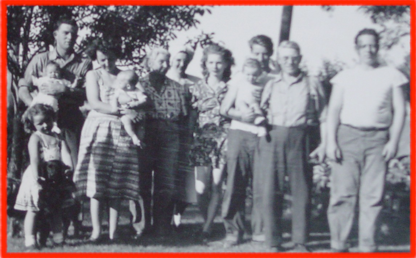
Photo of Boje Clan after Korena War had settled; left to right; Vernon and his sister Rose his three daughters: Cynthia, Mona & Susan; Catherine Boje, next is Vernon’s wife Dorothy Boje; then Lorane and Daniel Boje holding son, David; Then is August Boje; far right is Dennis Boje.
On Daniel Quentin Boje’s side of the family – His father is August Michael Boje and mother is Catherine Esther Haigh lived at 8212 Maringo, Spokane WN for a very long time. They had a farm, raised milk cows, geese, and other animals; had an aple orchard, grew their own corn, and kept a lot of bee hives. Daniel’s Father was August M. Boje; brother Dennis (Merchant Marine), Catherine Boje is his mother (born in Canada). Brother Vernon (married Dorothy) with children Cynthia, Mona, and Susan.
You see on both sides of the family ancestry, farmers, and warriors.
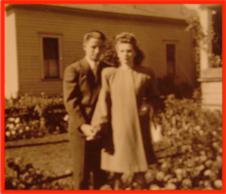
Lorane Joyce Eaton Married Daniel Quentin Boje Sep 25 1946
Both my parents are dead now. So I will give you a clue. She is showing. Lorane Joyce Eaton and Arnold Griswald (Spokane, WN) had twins, (born Dec 3 1946). Kenneth Daniel and Patrick John Eaton/Griswald died one and two days after (premature) birth, sometime soon after the marriage photo above.
Something else I learned late in life, a few years before dad died. “I never told this to anyone before [said my dad, Daniel]. I married Lorane [Sep 25 1946] when she was pregnant with the [Griswald] twins. Otherwise her people would have disowned her. That is just the way it was back then.”
So I am not the first born, but I am still the oldest survivor. I remember this house, as an toddler
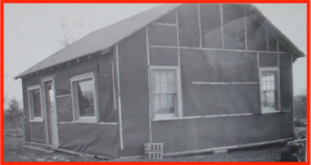
Daniel was building a bigger home, when he got called up from the Naval Reserves to serve once more. He hustled to complete the house. He was proud of it. He wanted to live close to the fram, my grandfather's farm. I recall living there.
Lorane worked for Lieutenant Colonel Urquhardt and Captain Swearingen at Camp Penford (near Pasco, WN) while Daniel was called up from Naval Reserves to serve on the USS Antietam.
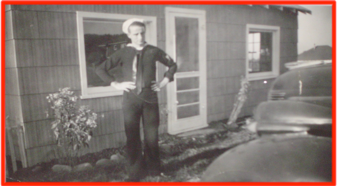
Dad managed to get the house finished before shipping out
Daniel Boje got a leave to come home for Steve’s birth Jan 19, 1952. Lorane worked right up to the birth, through the end of December 1951. They had to train seven people to replace Lorane; Lorane did the training.
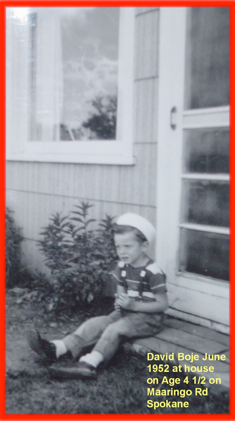
Sorry for mis-spelling of Maringo. Only photo I have.
Actually its a digital of the photo, that is now long gone. That is the finished house my dad built. My mother hated it. She did not want to live in a home-built house. She wanted the fancy brick houses in the suburbs, away from my grand parents farm, away from all farming, all wilderness.
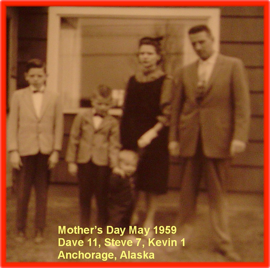
Daniel and Lorane were quite happy it seems in Washington, but, in retrospect, the move to Alaska was not a good idea. Daniel began popping pills to stay alert in his job on the White Alice defense network for Western Electric in Anchorage, Alaska. He stayed away form home, doing some social drinking, at the bar.
He got promoted when Western Electric was acquired by ITT, and moved the family to Paris, France
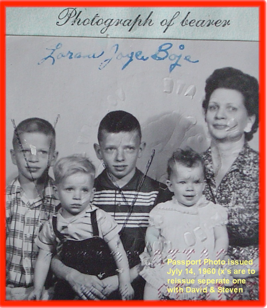
The first passport had to be redone for a trip to the UK (12 Aug 1961). There is a stamp in the passport 29 Apr 1961 (possibly our date of 1st arrival to France).
The mood of angst: There was a lot of drinking on both sides of my family. Dad told me he drank because he hated the marraige, hated his life, wished...
There is a stamp in each passport, NY, NY Sep 30, 1962 (date of the return to the US); less than two years in Paris, but had a major impact on everyone’s lives. Steven and David learned French, and went to French schools for the first year; then transferred to American School of Paris.

I took this photo. I have kept it. My mother is in the motel room, just arrived back from Paris. She is talking to my dad. There is a lot of yelling and screaming. He told her, "I am never coming back." I am the oldest, and younger siblings, Kevin, Steven, and Karen are in foreground.
The marriage ended when Daniel ran off with Jan (an English secretary, 18 years old). Lorane complained to SHAPE (Supreme Headquarters Allied Powers Europe) and to his corporate personnel officers at ITT. Jan was Daniel’s secretary for two years. Daniel had the family sent back to Spokane Washington, and after two payments stopped sending money, forcing the family onto welfare.
It is amazing to go from relatively upper middle class existence in Paris, France (wonder why I read French philosophy, and travel their every year for last 14 years) -- and to spiral down into a life of welfare, food stamps, and learn what poverty is really all about.
Lorane Joyce Boje was stranded in Washington. She did not know how to drive, had to manage four kids. She did not know how to drive, had not worked since Korean War. With a great deal of strength and fortitude she took care of her children. Lorane had to cope with the welfare system, a town (Spokane) without friends. The years in Spokane were stressful for everyone; never enough money, but in it all, Lorane took care of her family.
Lorane' Self absolutely froze (see frozen self theory). She was frozen in time, in 1962, and remained angry. She had some real PTSD. Mom did best she could, but with 2 kids and diapers, and the eldest boys (Steven and me), in trouble, most every day, she took to pills, tranquilizers.
I escaped poverty early on. The divorce with Lorane is final, and Daniel Q. married Jan. In 1967, David Boje (his son) is in jail and cannot get free. My uncle Vernon Boje, came by to enforce some discipline, and had David moved into the drunk tank and out of general jail area. The arrest incident: My not-to-close buddy (19 yr old) Don Gorder, just back from Marine boot camp, had KO-ed my landlord, and at the triall, I flipped off the judge. He was not amused. The judge threw the key away, and was never going to let me out. My dad, Daniel struck a deal with an old football buddy in the police department. I would be freed if he moved to New Jersey with his dad, and signed a paper that he would never, ever, return to the state of Washington. I was taken, still in handcuffs to say good bye to mother Lorane, sister Karen, and brothers Steven and Kevin. I was then driven right onto the airport runway in Spokane, the cuffs removed, and I signed. Id arrived in New Jersey, in Passaic and moved in with Daniel and his girlfriend, Jan. Then Steven got into trouble, and soon he was there too. Then Kevin and Karen came there. There was a lot of shuttling back and forth between Lorane in WN and Daniel in NJ.
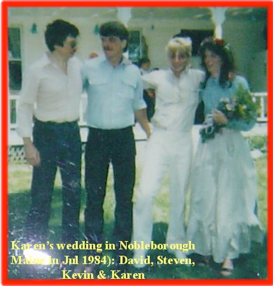
Let's cut to the chase. Stephen was hooked on heroine, Kevin on cocaine, and Karen addicted to alcohol. By the time I returned from Vietnam, I was drinking steadily. Stephen cleaned up his act, became manager of food bank and soup kitchen in Manhatten, but the long years with spirit of heroine demanded payment, and he died. Kevin is currently livng in a tent in Washtington State, in a state forest. Karen ran AA meetings in Olympia Washington, was sober for many years, and then took up with a drunk, fell off the wagon, and moved to Deming New Mexico. I heard in March 2014, Karen is back on the wagon since the anniversary of our dad's death (in 2010). I hope they continue in AA.
I stopped drinking alcohol about 20 years back. With so many addicted family members, I heeded my younger brother Kevin's advice, "Bro, you're getting older, addiction is hard to resist as you age." Good advice. Work has been an addiction, as it was for my father. I am cutting back.
August Michael Boje (born Leihigh Iowa in 1894; died in Spokane in 1975); stain glass window craftsman and put in church windows west of Mississippi; worked for Fuller Paint and Glass for about 45 years. In WWI trained at Fort Lewis, went to France Germany and had burial detail in France. His father’s name Henry Peter Boje (died in Renton, WN in 1940); ran an art store in the Renton/Auburn area; August’s mother was named Elizabeth Albang (both born in Germany). Daniel Q. Boje says that Boje definitely came from Denmark, and told a story ofter of going to Copenhagen and finding a Boje who could trace his dad, August Boje, in their family tree. Now you know why I travel to Denmark, visited there again March 2014.
According to Rose Corbin, “Grandfather Henry Boje was a scoundrel, in his younger years. He once ran off with another woman in his fit of passion to another town 25 miles away, and left grandmother and at least five children. Grandmother managed to get a horse and buggy, and probably a baby sitter, and went after him. She brought him back and managed to be married to him about 50 years. Grandfather [Henry Peter Boje] came to this country when he was 8 years old and was raised by an uncle in Iowa near Fort Dodge.”
“An interesting story, when he went to school there, the teacher arrived one morning to find a man in the school room, ‘naked.’ The predator had stolen his clothes. It was not mentioned if it was a prank or something else. ‘Something else’ was not talked about in my young years.”
“Grandfather did not get his citizenship papers until 1933 or the next year. In 1933 when Roosevelt became president, one of the first acts to be made was the Social Security Act. Boy how I remember how people 40 to 50 and thereabouts were scrambling about to get records of birth certificates, etc. in order to get their Social Security cards. Well, when grandfather was ‘naturalized’ (probably Seattle), there were about 90 people to be sworn in. The judge gave them a pep talk and finished ‘now all of you are eligible to vote.’ Grandfather said, ‘I never missed voting in my life.’ Then the judge said, ‘I ought to throw the book at you.’”
“Grandfather lived to be 92. And had been widowed 10 to 20 years at that time. He had Fred to care for. Fred had been to a picnic in the 1910 through 1919 era, and apparently some food spoiled in the heat. It follows that he had a bad time with ptomaine which had a lot of side effect. Fred became deaf and had an infection of the bone. They did not have penicillin or like antibiotics at that time. Medicine was only beginning at that time. The parents of Fred moved away to Auburn Washington. When I was 6 or 7 and Fred already had surgery on his knee, and that is another story. When the surgery was performed it was on the wrong knee to begin with. They patched that up, and operated on the other knee. It shows how the doctor paid attention to what he was doing. No Medicare or lawsuit, neither; those ideas had not been thought of. Grandfather after his wife died had a house to keep and Fred to care for. And Fred could only get around on crutches and his wheel chair.”– Rose Corbin (letter to Karen Boje).
On my dad's side, another famiy secret, how my grandfather's brother, Edward Bøje married a Pulalyup princess, and the prejudice of the day, so strong, he moved onto the Indian reservation. That famiy migrated to another state, where there are still Bøjes on the reservation. Yet, the name of this Indian Princess was never spoken by the other Bøjes, and is unknown to me, to this day.
Edward is the brother who married Puyallup Indian, and had children, Glen, Ida, Alex and Fred. There were others that did not live to maturity; one being named Rose (there were nine children in all). August Michael Boje married Catherine Esther Haigh (b. 1900, d. Aug 16, 1972
It is possible they moved to the Cheyeene Indian Reservations in Montana BOJE, ADOLPH & EDNA; BOJE, FLOYD & CAROLYN; BOJE, LILLIAN; BOJE, WILHELM & ANNA. (source).
In the Dawson Cemetery it lists
LAST FIRST BURIAL LOT OWNER BLK GRV
BOJE ADOLPH 1953 "BOJE, ADOLPH" 113 1 63 63B
BOJE LOUIS 1956 "BOJE, LOUIS & BELLE" 113 1 63
BOJE ANNA 1948 "BOJE, WILLIAM & ANNA" 113 1 129
BOJE BELLE 1963 "BOJE, LOUIS & BELLE" 113 2 63
BOJE EDNA 1986 "BOJE, ADOLPH" 113 2 63 63B
BOJE WILLIAM 1942 "BOJE, WILLIAM & ANNA" 113 2 129
BOJE JOHN 1986 BOJE 167 AmLn
The point here is my inter-generation web, has lots of colonization in it. On both sides of my family (Danish & Scottish) male relatives married Native American females, in a time in USA when there was even more prejudice and racism than today. Intergenerational-healing of the Living Story Web can not attain care or understanding while leaving these roots in ambiguity.
My Grandmother - Catherine Esther Haigh (born 1900 in Greenfield Minnesota) to Anne Baxter and a Mr. Haigh (both from England, but it is a Scottish name), married in Greenfield Wisconsin. Grandfather Haigh was the Queen’s farmer (probably Queen Victoria), so Rose Boje/Corbett’s mother related to her.
About the Queen’s Gardner, “he apparently took care of livestock and had a few of his own which he fed and groomed to take to the local fairs where he was able to gain some prizes. Anyone’s guess if he was fired or if thought he would be in the promised land if he immigrated to the USA.”
Catherine was orphaned at age 14, when her mother Annie Baxter Haigh passed away. She lived with her sister about one to two years. May had seven children and married to man who had seven more children. “Catherine was the oldest juvenile in the house. Everyday when she got home from school she had to peel a washtub full of potatoes, which were standard fare with milk gravy for dinner. The kids stood at the table except for the ones not tall enough to reach their food on the table. These little ones had boxes to sit on.
My Mother, Catherine [writes Aunt Rose] was revolted to anyone heaping their plate with food from this experience. She told us (my brothers and me) that we could always have seconds (seconds were out of the question, most times during the ‘Depression’ in the 1930s). Mays’ kids would load their plates across with potatoes and gravy, from rim to rim.
How Catherine got away from there to Spokane (plus the fare & a job) is anyone’s guess. I never asked, but I wondered. This N. Dakota episode at May’s house hardly had a fresh vegetable or fruit only once…” – Rose Corbin, Aug 1993.
Catherine had 14 sisters. She was a helper for a mortician. She was sent to secretary school and worked for DOC (dept of Corrections); her mother Annie Baxter died in Ferinebc, British Columbia. “Catherine was only able to go to school about two months a year, as the family was always moving. The stepfather [Mr. Bell] always had another scheme to make some money: a delicatessen, another time a peddler, or other things. So with a mixed up mess, Catherine was able to grade work wherever they moved, and entered high school at age 14. She would have finished high school, but for the fact that the flu epidemic of 1918 came along and she was working for board and room for a family that owned a funeral parlor and the woman said to her, ‘if she would quit school and stay full time at the house while the ‘crunch at the funeral home was on, they would pay her tuition in business school. She accepted that proposal. Then when she finished school she was able to get work at a doctor’s office. My guess that Catherine’s mother was a good teacher, Anne Baxter Haigh.” - story by Rose Corbin.
“Regarding Catherine Haigh’s stepfather (the girls called him Professor); he was form Virginia, played the fiddle, sang Steven Foster songs, which the girls laughed at. And once he was married to Annie Baxter Haigh, maneuvered to sell the farm and spend the money. Therefore the wanderer lived over a good part of Canada.
Catherine had one of the 14 sisters, in Cutbank Montana who married Cornelius Benjamin Smith. Cornelius may have remarried professor Bell from Virgina; had 14 kid; 7 of his and 7 of hers. A Mr. Bell (2nd husband) owned a taxi and limo service, one million silver dollars (a bit exocentric).
She had a sister Madge (married John Kondisko) in Portland, OR who had a son name Russell. “Son Russell, a teenager, was fixing the roof of the house, when his mother came out to scold her for something, and he sassed her. She went back in the house and when he went to sleep at night she disciplined him. I was never told how.”
Daniel Quinton Boje (born Aug 12 1924 in Spokane, died about 2002), was an inventor and a dreamer. Karen Boje, tells this story “whenever dad got into trouble his mother would make him take a bath; sometime five times a day.”
Daniel Quinton Boje was always able to amuse himself. He loved a good challenge. He played football in High School. He took his dad’s Model T for a joy ride. To hear him tell it he was always in trouble.
His side of the divorce story is that he lost his job at ITT with Loraine’s complaints, and without a college education and no job recommendation could not get one. So he moved with Jan to Passaic New Jersey, and worked in a chemical plant. It took hours to scour the paint and other chemicals off his body each night. One day he is emptying trash for the superintendent, who took a vacation. Daniel gets the idea to build a better way, a trash compactor, an idea he sketches on an envelop. He grabs a New York phone book, randomly picks a lawyer, and comes up a winner.
Daniel worked on his invention. Sam Permit is the top patent attorney in New York; Sam and brother, Saul Kestin put up the money for the invention, and Daniel begins to build the trash compactor. They sold it once it had a factory and sales, and each took One Million dollars.
Daniel lost his money within a year; $750,000 to an uninsured stock house that crashed, then the rest in two cash poor businesses, using up cash faster than profits were realized. He bought Jan a brand new V12 pink Jaguar. She took it and left when the money ran out.
Daniel bounced back with his enviable positive attitude and developed another million dollar invention; those big screen TV’s; got a design patent award for independent invention for U.S. Patent Office, something only given once every few years. But, his business partner, a British bloke, sold all the stock in their Big Screen TV company three times, and skedaddled back to the UK with all the money. The company went belly up. At that time Daniel married Patty. Patty had turned down a gig to pose for Playboy, but often talked about it. Daniel and Patty smoked a lot of pot, and generally had a good time. They took to drink fairly heavily and that led to his third divorce.

Daniel then moved to the forest, became a hermit much like Lorane’s father, Raymond Eaton. Daniel moved onto State Forest land deep in the woods of Oregon, near Port Orford. He stayed away from ex-wives and all people, and thought about his life. He decided to become an artist, to make wooden objects and sell them at swap meets. Several of his clocks are quite priceless (at least to his sons and daughter). He died in his sleep gripping the remote control for the TV. The sheriff says he seemed to be smiling. A funeral service was held in a Catholic Church in Port Orford Oregon.
Posthumanism, the respect for generation, for all species, for all living things, is at the core of my practices of sustainability. That posthumanism comes from rekindled native roots, denied in colonization. Posthumanism is also my Jain side. Marrying Grace Ann Rosile, another cross-cultural life-world came into my primordial living story. Jains have compassion for all life, meditate, and are vegetarian. Meeting Grace Ann, I made the choice to become vegetarian, and to transform my warrior Viking and Druid nature into posthumanist awareness. Getting in touch with Viking, Druid, and denied Native heritage, is a way to heal intergenerational soul wounds.
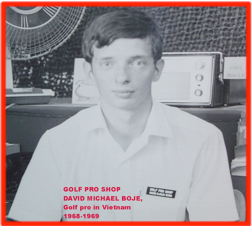
I finally got his life together, after being drafted in the U.S. Army in April 1968, and going to Vietnam 1969-1970 for a year.
Above photo shows me in golf shop in Saigon, Vietnam. First half of tour I was company clerk at USAHAC, Special Services, Quartermasters. He did payroll, reports and assignments for 15 units. Second half of tour after promoted to Sergeant, and refusing to reenlist, I became the golf pro. Ironic, Ie had never played golf in his life. Yet, I had time to read, and read up on it, and delighted in giving general’s advice on their hook and slice; no, they never caught on. I knew then he could teach. This was a turning point in my living story, a way of restorying, to head on a new path, to university life. I received veteran benefits paid my way through the Ph.D. That does not happen to vets anymore. I graduated 1st in his class form Burlington College, and then 1st again form Rider University (actually tied with a girl in the evening program). I then went to University of Illinois for his Masters and his Ph.D.
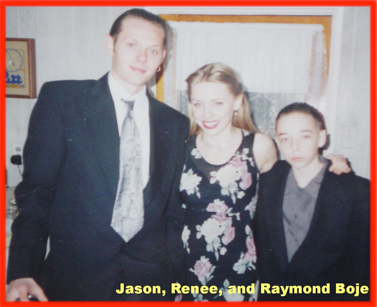
Had three children, first wife died after our divorce, from cancer, from swollen heart. Divorce runs in the family. All my siblings divorced. Soul wounds are intergenerational.
I am a Vietnam veteran, and that warrior spirit awakened in that denied war, has consequences for 7+7 generations. So I know how to relate to veterans, to people with addictions, to familes with soul wounds.
That is my living story, a struggle with so many Grand Narratives of colonial settlement, addictions, cross-cultural relations of Euro-settlers and Natives, and now a growing sense of the energy of all living things.
My living story calls to me. I hear it buzzing in my ears. There ae futures head my way. My choices now affect the 7 generations to come. My here and now is a way to heal wounds of 7 generations past.
Next, I give historical background to the theory and material-, ontological-, and quantum-practice of 'living story.'
LIVING STORY WEB THEORY
Living stories webs are ontological. Living stories webs are not whole, are without beginning or end, and just unfolding in the middle. And when a grand narrative retrospection tidies them up, edits them into a whole-ness, then the aliveness is gone. There is always in alivneness, a web of more and more living stories. Much of the formal western grand narrative analysis work, objectifies or subjectifies living story web-ness in ways that hides its ontology in once-occurrent Being (Bakhtin, 1993).
I first became aware of living story when I heard Kaylynn Twotrees (1997) conference presentation of how Lakota stories had a place, a time, and a mind, that was so important to survival of the tribe, that the penalty for getting it wrong was death. Twotrees (2000) have be more insight into how living stories are situated in the seven directions. This directionality is not compass headings, as much as they are life paths. Different tribes ascribe different meanings to directions of east, south, west, north, up, down, and in. Twotrees in October 2006 co-facilitated a Storytelling and Complexity Circle Conference in Las Cruces, New Mexico with Ken Baskin and myself (Bøje & Baskin, 2010).
My work on living stories (Bøje, 2001, 2005, 2006, 2007, 2008a, 2008b, 2009, 2011, 2012a, 2012d, 2012f) continued to apply Twotrees ideas of place, time, and mind. And I have delved more widely into Native American scholar's writing, in particular to ways in which living story is a materiality of survivance (Bøje, Jørgensen, & Strand, expected 2013, citing from our article next):
Stories connote a special sense of materiality, what Vizenor (1998: 15) calls "transmotion' defined as "that sense of native motion and an active presence, [that] is sui generis sovereignty" and "a reciprocal use of nature, not a monotheistic, territorial sovereignty." The transmotion of ledger art is a creative connection to the motion of horses depicted in winter counts and heraldic hide paintings" (p. 179).
Storied transmotion is a material "presence in stories, an actual presence in the memories of others, and an obviate presence as semantic evidence" and in a Bakhtinian sense "a dialogical circle" (p. 169) and "in a "dialogical context,‟ the conversions of [ethical] answerability" (p. 27, bracketed addition, ours).
I will now situate Gregory Cajete's work. He is working with Grace Ann Rosile, Ed Breeding, Joe Meier and others on a Native Wisdom and Ethics for Business film project. Cajete's (2000) Native Science book develops the idea that Western Narrative gets privileged over what I am calling 'living story. because living story's "material-agentive force" gets marginalized. "Native science is an echo of a pre-modern participation with the non-human world" (Cajete, p. 23). "Storytelling is a way of participation in and is interdependent with material conditions of a living life-world" (Jørgensen, & Strand, expected 2013); Living story therefore has material agency: "in this sense, community itself becomes a story a collection of individual stories that unfold through the lives of the people in that community" (Cajete, 2000: 95). This material agency of living story gives what I call disclosability in the Quantum Storytelling video.
Jo Tyler (2010: 62) participated in this same 2006 conference that Twotrees, Baskin, and I facilitated, and she wrote about living stories as having "story aliveness." Tyler cautions against functionalist"reductionist simplicity of the templates and algorithms" storytelling practitioners and consultants often use (p. 63). During the conference Tyler says she "arrived at the the threshold of the idea that stories are alive" and "alive whether or not we tell them" (p. 64). "Stories then are not lifeless tools" (p. 65), yet living stories, alive as they are "are not, however, completely in charge of their destiny" (p. 65). That destiny gets negotiated energetically, as a sort of energy of aliveness, and includes the living story rights and Bakhtinian answerability. This destining for Tyler and Twotree's directionality are part of the eleven D's in the video, Quantum Storytelling (Bøje, 2012). We (Bøje & Tyler, 2009) did a piece on living story in relation to workaholism for Journal of Business Ethics: "Living story recognizes the plurality of selves that constitute our
identity, and our reflexivity that is out of time, more upon what lies below and above" (p. 173). Rather than out of time itself, we mean out of the ordinary clock and calendar time, and instead in a quantum time.
Finally, Ardent's (1958) work puts "storytelling" (p. 50) in relation to what we call living story (e.g. p. 19) or what she terms "a recognizable life-story from birth to death." This is the primordial definition of life-story, that is Heideggerian, but for Ardent, it is distinguished from the environment of things and is more about "movement of biological life" (ibid, p. 19). Ardent wants to recover 'action' identity of Self from the work and labor identities. Ardent (ibid, p. 20) looks at the interplay of eternity (as epistemic), mortality (the rectilinear course of things & biological life), and potential immorality (more an ontological life story). One could read between the lines of Ardent, a critique of Heidegger (1962/1996), as a striving for immortality way of life, without attending to answerability (in Bakhtinian sense) of responsibilities of citizen of the world. In Bakhtin (1991, 1993) answerability in once-occurrent Being-as-event-ness is an ethical compellent action, i.e. an ethics of living story. Living Story is a part of 'Storytelling.' For me, storytelling is the big picture, the whole dynamic.
WHAT IS STORYTELLING?
Two amazing definitions of storytelling are by Walter Benjamin (1936) and Hannah Arendt (1958), and a recent one by Bøje, Jørgensen, & Strand (2013). Benjamin (1936: 83) begins by proclaiming, “The art of storytelling is coming to an end.”
All great storytellers have in common the freedom with which they move up and down the rungs of their experience as on a ladder. A ladder extending downward to the interior of the earth and disappearing into the clouds is the image for a collective experience to which even the deepest shock of every individual experience, death, constitutes no impediment or barrier (Benjamin, 1936: 83).
This I take to be an ontological standpoint on storytelling, and how it is coming to an end with the rise of narrative, and information, displacing the material social conditions where people learned not only storytelling but story-deciphering in story-listening, as well as storytelling-participation to co-create storytelling. Benjamin's ontologic storytelling is this shift in aesthetics that Gertrude Stein (1935), in her classic lecture series, also saw the way the information society increasingly celebrates narrative and information processing, yet also a loss of celebrated the storyteller, who lived in a world of storytelling competencies that changed radically with modern and now our late modern capitalism. Now only the managers sit around honing their storytelling skills, in one meeting after another, while the laborers and workers are separated, yet storytelling in their virtual connectivity on the internal and external Internets.
Hannah Arendt, another critical theorist, wrote the introduction to Benjamin's (1968) book. Ardent's (1958) book, the Human Condition, quotes Erwin Schrödinger (p. 3) as well as Werner Heisenberg (pp. 153, 261, 270, & 287). As Ardent may be less known in storytelling scholarship than Benjamin, I want to spend some quality space on her work, and point out why it is ontological, and how it differs from other ontological storytelling work.
Arendt's (1958) definition of storytelling is ontological, about the lived life of action, and how identity has changed since the ancient Greeks, to where labor and work identities trump the action identity of Self. Arendt was a student of Martin Heidegger, and some say a lover, but parted ways with his ontology, finding he was not practicing what he preached about 'care' in Being-ness.
Ardent developed her own ontology of the way in which 'action' had been overtaken by 'work' and 'labor.' These three action (contemplation and life in polis), labor (coerced necessity to survive, and not much freedom of movement) and work (chosen pursuits with more freedom of movement) are part of the Vita Activa, a vitalistic idea of Being and identity in-the-world, that over the years a hierarchy formed driving action to the margins. "Action" says Arendt (p. 8) is 'the only activity that gets on directly between men without the intermediary of things or matter" and corresponds to the "condition of plurality, to the fact that men, not Man, live on the earth and inhabit the world." You could say Heideggerian ontology forgot about 'action' and focused on the equipmentality, the technologies and process of work and labor. For Ardent, time in the world of things, in Marx's labor-time, labor-power, and work-time is not the same as a life of action, in plurality of political activities and natality of life (pp. 8-9). Nevertheless the "thing-character" of labor and work, and the "human condition" of action supplement one another (p. 9). For Heidegger (1962/1996) the thing-hood of a thing was its use, the in-order-to, for-the-sake-of, that is what I call 'deployability' in the Quantum Storytelling video.
There are certainly remnants of Heideggerian ontology in her work, such as sections on the "dwellers of the universe" (p. 3), but to her "work provides an 'artificial' world of things, distinctly different form all natural surroundings" (p. 7), and "place" (pp. 39, 70). Place that was private, where the laborers, women and slaved, dwelled, has undergone a transformation from ancient times, through early modern, and into modern and late modern capitalism. It is a transition, by storytelling, in "abolition: of the "place of one;s own: labor-power, where it is not long a place of dwelling in the private realm, and instead we "consume daily" (p. 70). It is a process of disintegration with the consequence of the dissolution of the private realm of labor, because the process of accumulation has become a permeance process in late capitalism, where the social has evaporated both the private and public realms, and changed our identity of Self into a self.
Our modern discovery of living story (explained below) is too late as Benjamin says, because we now discover our only flight from the social is into what Ardent (1958: 69) calls the "inner subjectivity of the individual, which I am designating with small 's' or 'self.' The move from public/private to social/individual is also "evaporation of the tangible" thing what our property is no linger fixed in Marx's "labor-power" or tied to "strength of this body" but in the most revolutionary move " of modern capitalism, we have a conception of property that is the very dissolution of the private realm, where there is a "transformation if immobile to mobile property" such as we have witnessed in the downward global spiral-antenarrative of home-properties turned into virtual instruments, traded between banks as commodities. Home property and their foreclosures becomes intangible, a 'fungible' sort of thing, an object of "consumption" that has lost its private use value (p. 70). And not just in economics of Western late modern capitalism.
Ardent (1958: 50) says the physical and social sciences have made the "public realm" irrelevant", not having "any tangible, worldly reality" because of "the fact that no activity can become excellent if the world does not provide a proper space for its exercise." Without the public realm of storytelling what is seen and heard by everybody is not revealed and does not gain any possible publicity" (ibid, p. 50). What is in in the "shadows of the hearts" in our "intimate life", our "delight of the senses" and our innermost "thoughts of the mind" becomes privatized, individualized, and cut off from the world of Being. "The intimacy of the heart, unlike the private household, has not objective tangible place in the world..." (ibid, p. 39). Now we get to Ardent's profound definition of storytelling:
"The most current of such transformations occurs in storytelling and generally in artistic transpositing of individual experiences" (ibid, p. 50, bold mine).
And it is a transpositing from action into social. It is storytelling that changes the relation of the Vitae Activa. The Vitae Activa is the relation of action, labor, and work, and it is all about the identities of ontologic 'Self' and epistemic/empiricist 'self.' With the rise of the social, the empiricism of behaviorism overshadowed the ontology of action. Something changed, in what I call the 'heart-of-care' (Bøje, 2012c), and the sort of 'care' one finds in Heidegger (1962/1962) became just about environments of work, supplies, equipment, welfare, and here and there, Nature. In Marx it became labor-power and use. For Arendt, it is about 'action'.
The way that this transpositioning of public realm of what I call 'living story' (defined below) to its worldlessness identity of 'self' is through acts of narrative, and by the some connective antenarratives that move that process along (e.g. linear-, and cyclic-antenarratives; see antenarrative section of essay). Two ways 'living story' reconnects to the ontology is of living story 'Self' recovering from 'self' or as Heidegger (1962) calls it, the 'they-self' to the 'potentiality-for-Being-a-whole-Self is through other antenarrative processes (e.g. spiral-, and rhizomatic, see Bøje 2011, 2012d, f). You can think of these as forces and counter-forces of antenarratives connecting living story to narrative, differently.
Like Benjamin (1936) and Stein (1935), for Ardent (1958: 39) "the rise of the novel" changes not only storytelling, but for Ardent also results in a "decline of the more public art" resulting in "conformism" in society, as the social group overtakes family and "excludes the possibility of action" (p. 39-40). In other word, the social 'self' conforms, and there is less place for an authentic Self. It is as if what is important in Ardent's storytelling ontology, in terms of the material action of life, gets rules as immaterial with the rise of sociology of groups and the behaviorism of the individual in groups. Why? Because in conformism, people "behave and do not act" out action (pp. 40-41). In storytelling, as Bakhtin (1991, 1993) stresses there are 'deeds and acts.' The small deeds and acts, in a quantum storytelling sense, make big waves, and collapse waves. But as social science statistics takes over, Ardent (1958: 42) concludes "the justification of statistics is that deeds and events are rare occurrences in everyday life and in history." It is too easy nowadays for narrative just to leave out the little things of living stories and focus on the monological (Bøje, 2008). Storytelling, by contrast, can illuminate "historical time" with a few acts or deeds, what statistics of large numbers levels out (Arendt, 1958: p. 43).
And finally, our own definition of storytelling as the domain in which living story, narrative, and antenarratives intra-act in a new materiality way (Bøje, Jørgensen, & Strand, expected 2013: 3):
"Storytelling, here, is defined more broadly, as something agential such as the iterative intra-active-material-storytelling domains of "living stories‟ and "antenarratives‟ in the theatre of action, which go beyond the classical narrative focus on structuralist and representationalist elements and retrospection (Bøje, 2001, 2008a)."
Above is what Strand (2011, 2012) terms 'material storytelling' is put into relation with living story and antenarrative pathways. Next, something about narrative.
WHAT IS GRAND NARRATIVE?
Grand Narrative is most often retrospective, looking backward, while walking forward (Bøje, 2001, 2008a, 2011, 2012a to f; Bøje & Tyler, 2009) and has been so oriented since Aristotle (350 BCE) has become the linear sense of plot required to have a beginning, middle, and end. See Ellen O'Connor's 'What is Narrative' Prezi about beginning, middle, and end. For example a middle....
Grand Narrative requires living story to be a proper "imitation of an action that is complete in itself, as a whole of some magnitude... Now a whole is that
which has beginning, middle, and end" the definition of coherent narrative (Aristotle, 350 BCE: 1450b: 25, p. 233).
Grand Narratives are dangerous to the survivance of Living Story Webs of entrepreneurship. Grand Narratives use a different sort of agential cut (see section below for definitions), a move to generalize, to cut away the living ground, and the materiality of living story web. Grand Narrative cuts off the kind of exploration, the curiosity-mood, as we shall explore, of the entrepreneur. In each context there are many Grand Narratives that privilege one standpoint over any others, and that status quo prevents inquiry. And each Grand Narrative has an ideology that marginalizes others' ideologies, and that cuts off inquiry into what is concealed, hidden, and undisclosed to the entrepreneur. Lyotard, Jean-Francois. (1979/1984). For more on Grand Narrative, see The Postmodern Condition: A Report on Knowledge , (Vol. 10). University of Minnesota Press. (1979 in French’ 1984 English translation).
Here is an online version of the Lyotard book: http://www.futuroscopio.org/wp-content/uploads/2010/07/Lyotard-the_postmodern_condition_a.pdf
In 2012a I work out this chart, that can serve as an overview of the history of narrative in various disciplines and nations (Bøje, 2012a, in press), which I have adapted here and there, such as including quantum storytelling.
Table 1 – Brief Genealogy of Storytelling Approaches
- Greece Narrative Poetics - Aristotle – (350 BCE) Poetics – duality of hierarchic-narrative-form and epic story; Aristotle’s Physics (Physis).
- Germany Historical Materialism – Karl Marx’s (1818-1883) revision of Hegelian dialectic, then Horkheimer & Adorno Critical Theory sorts of storytelling of culture industry
- Russia Formalism (1910-1930s) – began as duality of narrative (suzjet) & story (fabula), then to an organic sort of poetics
- US –Structuralism & New Criticism (1930s and 1940s) - Brooks, Ransom, Warren & Wimsatt
- France Structuralism (1950s & 60s)– the anthropologist Claude Lévi-Strauss (influenced Barthes
- France - Poststructuralism – (1970s & 1980s) its precursors, its theorists, and repercussions. Derrida, Foucault (middle), Barthes (late), Lyotard (sometimes) …
- Bulgaria Approaches to Literary Genre (1980s & 1990s)– Tzvetan Todorov - Equilibrium is opposed to disequilibrium; Julia Kristeva – intertextuality and feminist studies
- Swiss à German à French Hermeneutics – Hans-Georg Gadamer, Wolfgang to Heidegger to Ricoeur & Sartre
- Russia Heteroglossia (1980s 1990s)– Mikhail Bakhtin’s work translated late into English
- Denmark & Scotland (2000-2010s) – Quantum Storytelling- David Bøje (1/2 Danish & ½ Scottish).
Narratology has studied narrative Poetics, Marxian historical materialism, Russian Formalism, various Structuralisms, and Poststructuralism, Literary Genre, various Hermeneutics, the Russian Heteroglossia of Bakhtin, and now there is what I call quantum storytelling, which since I am Danish and Scottish on dad and mother's side, I list those nations. And what would a quantum storytellling make of narrative? That is a topic for another essay. I will say that Ardent (1958), late-Heidegger writing, Mead (1932), among others write about the ways quantum physics is changing our understanding, interpretation, and according to Heisenberg (1968) the language is also changing, moving away from classic physics concepts (Bøje, 2012d ,f). Mead (1932/1980: 61, 153) cited Bohr, but not Heisenberg, developed quantum implications in his Philosophy of the Present. Mead (1932: 36) “thus the future is continually qualifying the past in the present.” Heidegger's (1962/1996) ontology is about the future-ahead-of-itself, e.g. “The primordial phenomenon of the future as coming towards”; (Heidegger, 1996 #325. P. 373). Hannah Arendt (1958: 153, 261, 279, 287), on the other hand cites Heisenberg, but not Bohr.
So to the extent narrative is retrospective, and heteroglossic language of discourse, it will change its representations, its language, its themes of materiality will be represented differently.
Next, I give some background on antenarrative, and get on to the main topic of this essay, living story.
WHAT IS ANTENARRATIVE?
Antenarrative has a double-meaning of ‘ante.’ First, ‘ante’ as Being before narrative cohesion sets in, and second as a bet on shaping the future that is prospective-sensemaking (Boje, 2001).Used as an adverb, “‘ante’ combined with ‘narrative’ means earlier than narrative.” The antenarrative paradigm privileges living story emergence over a more coherent retrospective-narrative and emplotment. Four types of antenarratives connect narratives of the past, and living stories of the present. Linear- and cyclic-antenarratives assume the past patter will recur in the future, whereas spiral- and rhizomatic-antenarratives work from future to present and future to past (Boje, 2007, 2008a). Finally the 2011 Handbook on Antenarratives (Boje, 2011), Boje and colleagues, extends antenarrative work to a wide range of topics. There has been other important work with his colleagues (Boje & Rosile, 2002, 2003; Boje, Rosile, Durant, & Luhman, 2004; Boje, Rosile & Gardner, 2007; Smith, Boje & , 2010). And by academics applying antenarrative in organization studies (Barge 2004; Collins & Rainwater, 2005; Durant, Gardner, Taylor, 2006; Vickers, 2005; Yolles, 2007) and most recently, Grow (2009); Vaara and Tienari (2012). For more on Antenarrative see main link to 'What is Antenarrative.'
What is Quantum Storytellng?
Quantum storytelling involves the disclosability of different materialities inta-weaving with storytelling. For Baradians, its a matter of Bohr's apparatus of observation as the effect. For Heisenbergians its the potentiality distribution of future pathways.
Arendt and late-Heidegger essays refer to Heisenberg’s quantum interpretation. I am reading his book, again and again, on Physics and Philosophy (1958). She cites Heisenberg several times. Her ontology, never cites Heidegger, yet one can read between-the-lines an intriguing critique of Heideggerian ontology. That is, that is his mania for work and labor instead of the action activities of Being human, and how in modern capitalism work and labor activities now overshadow the action activities of the Vitae Activa. Further, she puts eternity, immortality, and mortality into relationship, which between-the-lines is a critique of Heidegger’s stress on the primordial birth-to-death mortality, and trying to do something monumental (Nietzsche) to achieve immortality.
The unconcealedness I see in quantum storytelling is there is much more going on than the common interpretation of observer effect, i.e. that you cannot accurately measure wave and particle effect (motion & position) at the same time. Rather more intriguing is how Heisenberg (1958) has what Northrop in the introduction to the book calls a weak teleology, which is tied somewhat to Aristotelian potentia. An acorn does not grow up to be a maple tree or an elephant. The more I delve into the differences in Bohr and Heisenberg quantum interpretations, the more I am finding that the common interpretation of ‘observer effect’ (i.e. observer apparatus) is rivaled by Bohr’s ‘complementarity principle’ (i.e. the universe would come apart if an electron wave could eat its own tail in its orbit around an atom) and Heisenberg’s ‘indeterminacy principle’ (that electron can be both wave and particle at the same spacetime). Einstein counter-argument to the Copenhagen interpretation, was 'God does not play dice with the universe.' Heisenberg's (1958, see Northrop introduction) response, 'God does play dice.' Our living story is ontological, our material-agential aliveness, our pathway of Being-in-the-world.
CONCLUSIONS
Living Story is a material-agency of aliveness, in the once-occurrent Being-ness of the life-world, and has to contend with Western Narrative inclinations to empty living story of that aliveness. Living story has spacetimemattering in its quantumness, as there is a place, a time, and a material-mattering. It is not geometric or geographic place, not clock or calendar time, and not the mattering of classical physics. Rather it is a quantum aliveness that interconnects all life, even the live of metals like iron, and cooper, and carbon atoms, in the quantumness of life in a posthumanist ontology of living story.
References
Arendt, Hannah. (1958). The Human Condition. Chicago/London: The University of Chicago Press.
Aristotle (written 350 BCE). English (1954) translation Aristotle: Rhetoric and Poetics. Introduction by Friedrich Solmsen; Rhetoric translated by W. Rhys Roberts; Poetics translated by Ingram Bywater. NY: The Modern Library (Random House). Poetics was written 350 BCE.
Bakhtin, M. M. (1990). Art and Answerability. Edited by Michael Holquist & Vadim Liapunov. Translation and Notes by Vadim Liapunov; supplement translated by Kenneth Brostrom. Austin, TX: University of Texas Press. From Bakhtin’s first published article and his early 1920s notebooks.
Bakhtin, M. M. (1993). Toward a Philosophy of the Act. Translation and Notes by Vadim Liapunov. Edited by Michael Holquist & Vadim Liapunov. Austin, TX: University of Texas Press. From Bakhtin’s early 1920s notebooks. 1993 is First English printing.
Barge, J.K. (2004) `Antenarrative and Managerial Practice' , Communication Studies 55(1): 106-27.
Benjamin, Walter. (1936/1955/1968). "The Storyteller: Reflections on the Works of Nikolai Leskov." Pp. 83-109 in Walter Benjamin Illuminations, Hannah Arendt (ed.) was first published in 1936 (Orien Und Okzident); again in 1955 in German, and 1968 is the first English translation. NY: Harcourt, Brace, and World, Inc.
Boje, D. M. (2001). Narrative Methods for Organizational & Communications Research. London: Sage.
Boje, D. M. (2005). Wilda. Journal of Management Spirituality & Religion, Vol 2 (3): Article: 342-364, Epilogue: 399-405. (with accompanying commentaries by Eduardo Barrera, Heather Höpfl, Hans Hansen, David Barry, Gerald Biberman, Robin Matthews & John W. Bakke).
Boje, D. M. (2006).Breaking out of Narrative's Prison: Improper Story in Storytelling Organization. Storytelling, Self, Society: An Interdisciplinary Journal of Storytelling Studies. Vol 2 (2): 28-49.
Boje, D. M. (2007). Chapter 13 Living Story: From Wilda to Disney, pp.330-354. Handbook of Narrative Inquiry: Mapping a New Methodology. Edited by Jean Clandinin, London: Sage.
Boje, D. M. (2008a). Storytelling Organizations. London: Sage.
Boje, D. M. (2008b, Ed). Critical Theory Ethics For Business and Public Administration (Charlotte, NC: Information Age Press
Boje, D. M. (2009). Excess of history and dance of narrative with living story noticing. Tamara Journal of Critical Organization Inquiry. Vol 8 (1): 80-94
Boje, D. M. (2011, Ed). Storytelling the Future of Organizations: An Antenarrative Handbook. NY/London: Routledge.
Boje, D. M. (2012a). Reflections: What does Quantum Physics of Storytelling Mean for Change Management? Journal of Change Management, accepted 7/22/2011
Boje, D. M. (2012c). "The ♥-of-Care of the Life-Path of Organizations through Landscapes of Quantum Fields", working paper on https://davidboje.com
Boje, D. M. (2012d). , Quantum Storytelling: Blacksmithing Art in the Quantum Age, Video accessed May 25, 2012 at http://www.youtube.com/watch?v=a7pm_mRwL-0
Boje, D. M. (2012f). Quantum Storytelling. Free online book (until it gets finished with its revisions, and a publisher calls)
Boje, D. M. (2014) Storytelling Organizational Practices: Managing in the Quantum Age. London/NY: Routledge.
Boje, D. M.; & Baskin, K. (2010). Dance to the Music of Story: Understanding Human Behavior through Intervention of Storytelling and Complexity Thinking. Litchfield Park, AZ: Emergence Publications.
Boje, D. M.; Durant, Ivy; Coppedge, Krisha; Marcillo-Gomez, Marilu; & Chambers, Ted. (2011). Social Materiality: A New Direction in Change Management and Action Research. Pp.580-587 in The Routledge Companion to Organizational Change, Edited by David Bøje, Bernard Burnes, John Hassard.
Boje, D. M.; Jørgensen, Kenneth Mølbjerg; & Strand, Anete M. Camille. (expected 2013) Towards a postcolonialist Storytelling Theory of management and organization," accepted 9/27/2011 for publication in Journal of Management Philosophy. Click here fore pre-press PDF.
Boje, D. M. & Rosile, G. A. (2002). Enron Whodunit? Ephemera. Vol 2(4), pp. 315-327.
Bøje, D. M. & Rosile, G.A. (2003). Life Imitates Art: Enron’s Epic and Tragic Narration. Management Communication Quarterly. Vol. 17 (1): 85-125. See pre-press PDF.
Boje, D. M., Rosile, G.A., Durant, R.A. & Luhman, J.T. (2004) "Enron Spectacles: A Critical Dramaturgical Analysis". Special Issue on Theatre and Organizations edited by Georg Schreyögg and Heather Höpfl, Organization Studies, 25(5):751-774.
Boje, D. M.; Rosile, G. A.; & Gardner, C. L. (2007). "Antenarratives, Narratives and Anaemic Stories" Chapter 4, pp. 30-45, Storytelling in Management, Editors: Ms. Nasreen Taher and Ms. Swapna Gopalan, Publisher: The Icfai University Press, India, First Edition: 2007 (Note: was based upon Paper presented in Showcase Symposium, Academy of Management,. Mon. Aug 9 2004 in New Orleans). See conference version.
Boje, D. M.; & Tyler, J. (2009). Story and Narrative Noticing: Workaholism Autoethnographies. Journal of Business Ethics,* special issue on workaholism, Vol 82 (2): 173-194. Click here for pre-press PDF version Actual printed version form Springer if you have that access
Cajete, Gregory. (2000). Native Science; Natural Laws of Interdependence. Santa Fe, NM: Clear Light Publishers.
Collins, D. & Rainwater, K. (2005). "Managing change at Sears: a sideways look at a tale of corporate transformation". Journal of Organizational Change Management, Vol. 18, No. 1: 16-30.
Durant, R.; Gardner, K.; & Taylor, K. (2006). Indexical antenarratives as invitational rhetoric. Tamara Journal of Critical Organization Inquiry, Vol. 5 (3/4): 17-182.
Grow, Jean M. (2009), “The Gender of Branding: Antenarrative Resistance in Early Nike Women’s Advertising,” Women’s Studies in Communication, 31/3, 310-343.
Heidegger, M. (1962). Being and Time. Translated by J. Macquarrie and E. Robinson. San Francisco, CA: Harper Collins.
Heidegger (1996). Being and Time. Translated by Joan Stambaugh. State University of New York Press, Albany NY.
Heidegger, M. (1999/2008). Ontology--The Hermeneutics of Facticity. Indiana University Press.
Heisenberg, Werner. (1958). Physics and Philosophy: The Revolution in Modern Science. Introduction by F. S. C. Northrop. NY: Harper & Brothers Publications.
Mead, G. H. (1932/1980). The Philosophy of the Present. Edited by Arthur E. Murphy with Prefatory Remarks by John Dewey. London/Chicago: University of Chicago Press. First Phoenix Printing, 1980.
Smith, William L.; Bøje, David M.; & Melendrez, Kevin D, (2010) "The financial crisis and mark-to-market accounting: An analysis of cascading media rhetoric and storytelling", Qualitative Research in Accounting & Management, Vol. 7 Issue: 3, pp.281 – 303.
Stein, G. 1935. Narration: four lectures. Introduction by Thornton Wilder. Chicago, IL: University of Chicago Press.
Strand, Anete Mikkala Camille. (2011). Presentation on ‘material storytelling’ to 20th anniversary meeting of sc’MOI, meeting in Philadelphia, April.
Strand, Anete Mikkala Camille. (2012). The Between: ON Dis/continuous intra-active Becoming of/through an Apparatus of Material Storytelling. Unpublished Doctoral Dissertation, Aalborg University, Denmark.
Twotrees, K. (1997). Presentation at the Organizational Behavior Teaching conference, meeting at Case Western Reserve, Ohio.
Twotrees, Kaylynn. (2000). Seven Directions practice: A Practice for the Crossroads, The Fourth R (Vol. 92, August, Sept, October) published by CRENet (Conflict Resolution in Education Network).
Tyler, J. (2010). Story Aliveness. Chapter 3, Pp. 61-81 in D. M. Bøje and Ken Baskin (Eds.) Dance to the Music of Story: Understanding Human Behavior through Intervention of Storytelling and Complexity Thinking. Litchfield Park, AZ: Emergence Publications.
Tyler, J. (2011). Living story and antenarrative in organizational accidents. Pp. 137-147 in Boje (ed) Storytelling and the Future of Organizations: An Antenarrative Handbook. NY/London: Routledge.
Vaara, E., & Tienari, J. (2011). On the narrative construction of multinational corporations: An antenarrative analysis of legitimation and resistance in a cross-border merger. Organization Science, Vol. 22 (2): 370-390. Tienari,_Vaara.pdf
Vizenor, Gerald. (1998). Fugitive Poses: Native American Indian Scenes of Absence and Presence. Lincoln: University of Nebraska Press.
Vickers, M. H. (2005). Illness, work and organization: Postmodern perspectives, antenarratives and chaos narratives for the reinstatement of voice. Tamara: Journal of Critical Postmodern Organization Science, 3(2), pp. 1-15.
Yolles, M. (2007). The dynamics of narrative and antenarrative and their relation to story. Journal of Organizational Change Management. Vol. 20, No. 1: 74 – 94.

